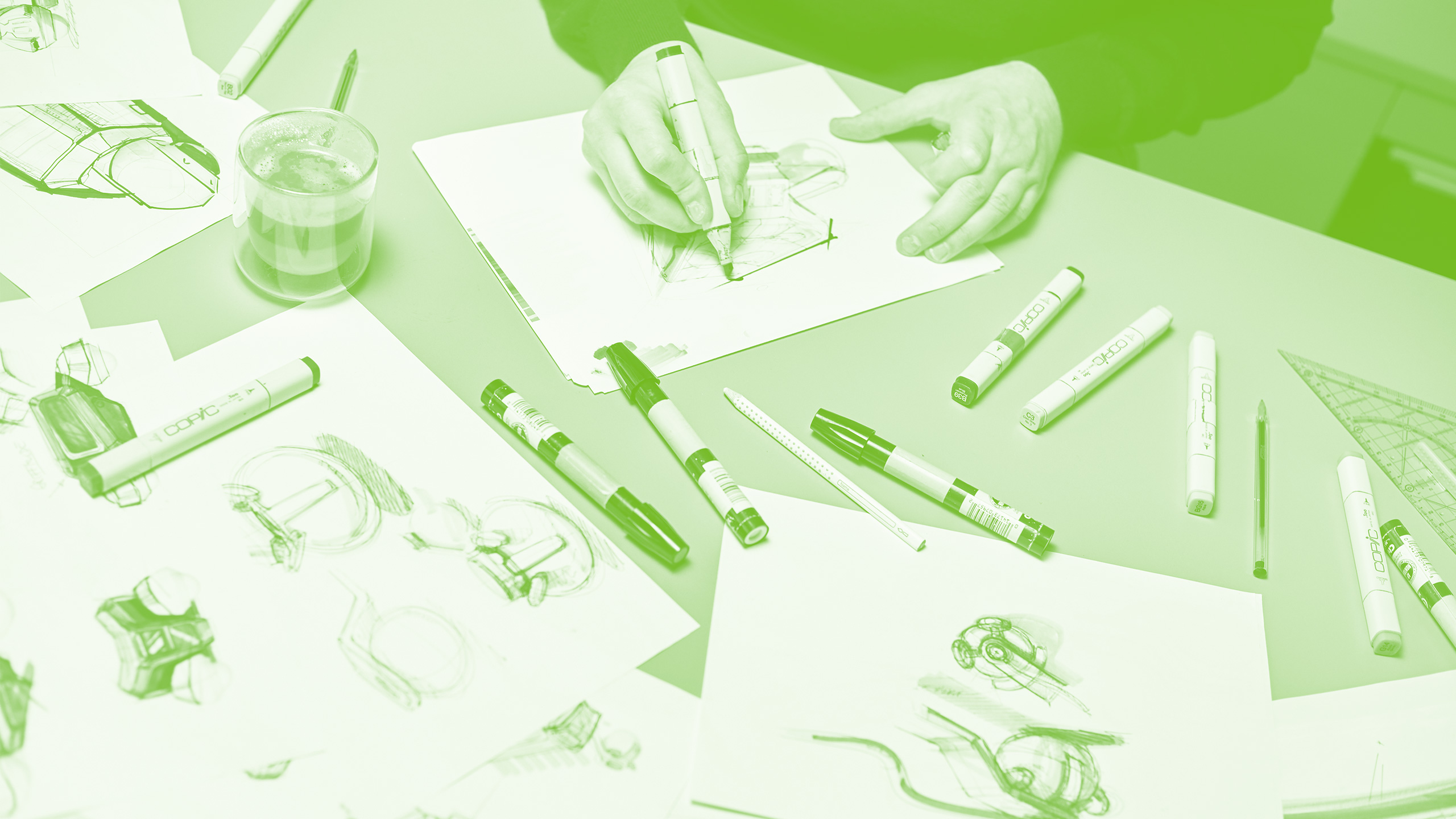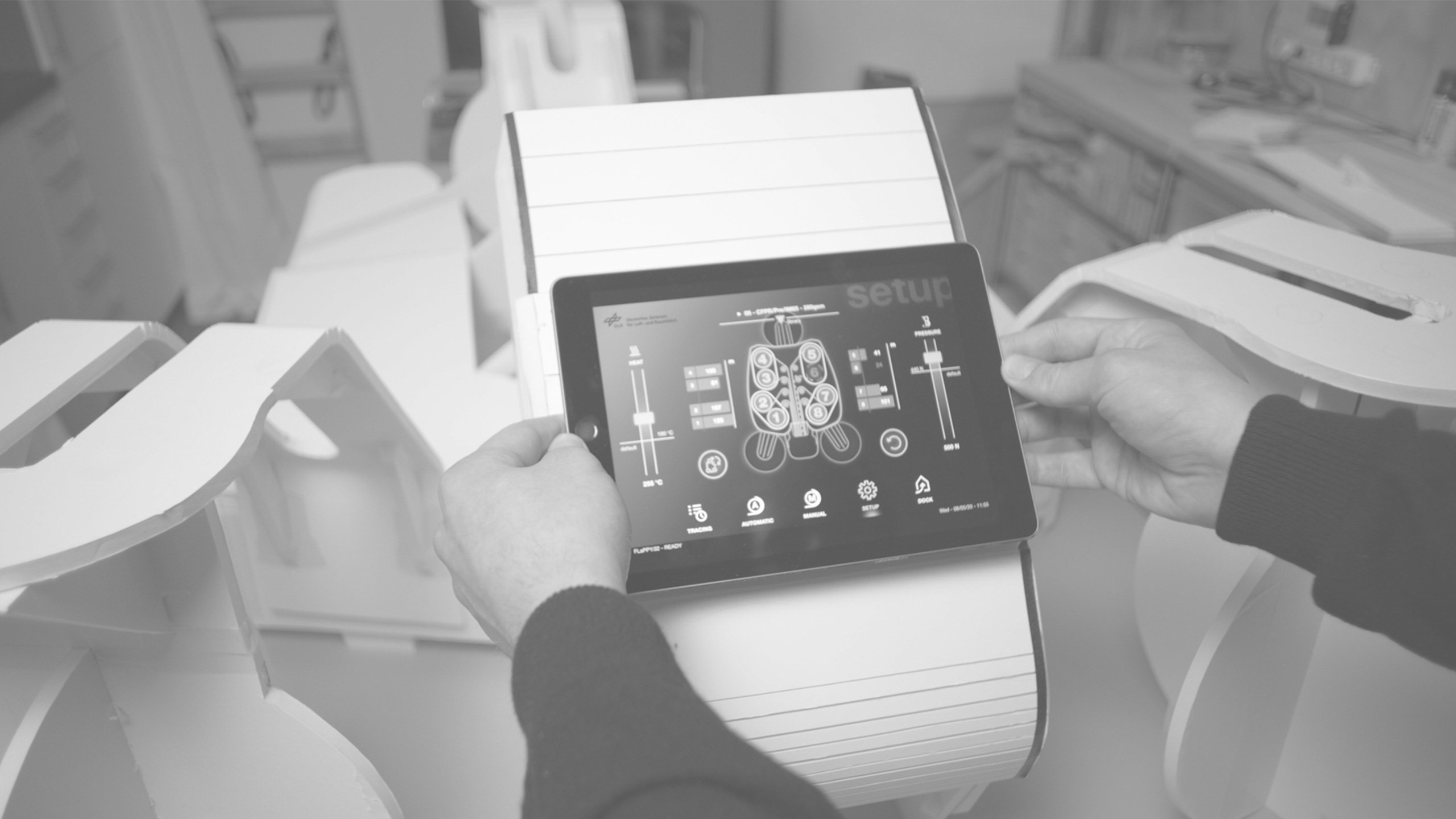Strategic Design Base
- Design strategy goals
- Design process and methods
- Design systems
- Design anchor
Creative Design Core
- User Centered Analysis
- Ideation
- Creation
- Realisation
Agile Design Proof
- Prototyping
- Usability Tests
- Implementation support
With your project goal in mind, we use our service modules from the areas of strategic design base, creative design core and agile design proof to develop a customised design process tailored to your needs and project requirements. Depending on the project, you can assign either individual phases or the entire process to us. We look forward to meeting you and learning more about your challenges.


We manage all of our projects strategically, with the aim of integrating all stakeholders and strengthening the product brand and corporate identity in a sustainable manner and based on a coherent design language. To achieve this, we set goals, define the process and methods, develop design systems and support the realisation of the design strategy across all business units.
We review the task at hand in the context of the product’s ecosystem. We analyse the corporate and brand context, determine the design requirements, while incorporating technical framework conditions as well as feedback from the market. Your added value: a solid basis for a brand-consistent user experience that also considers any future design developments.
We plan the entire design process and advise you regarding the individual steps and an effective use of methods to ensure that your project progresses smoothly and you accomplish the defined goals within the agreed timeframe.
We develop visual brand languages and design system documentations to strengthen brands internally and externally, to assure quality, and to enhance the efficiency of future design developments.
We support our clients in anchoring their new design strategy in the entire company. Because a product’s design quality can only be increased sustainably if the new design is understood, internalised and embraced by all stakeholders.

To swiftly arrive at innovative and resilient solutions that meet the needs of prospective users, we harness the creative potential of everyone involved. As part of interdisciplinary stakeholder teams, we jointly develop new, creative ideas that are subsequently specified and visualised and thus become tangible and understandable. To communicate our solutions to engineers and programmers, we create design specifications for a successful implementation.
We analyse the task at hand in the context of the product life cycle, with a focus on the user. We talk to future product users and review each and every step. We look into the product’s environment, technology and features, the market and the brand. Based on this, we develop holistic requirements for the design process.
Following the analysis, we host ideation workshops and design sprints with different stakeholders. We make use of a range of creativity techniques to get off the beaten track and to generate as many original ideas and visions as possible.
We translate ideas into coherent overall concepts, visualise them and make them tangible and understandable. The aim is to obtain initial feedback from users and stakeholders and to prepare for the next decision-making steps. Based on the selected concept, we develop alternative design directions and optimise the chosen design as part of an iterative, multi-stage process.
For the implementation phase, we document all relevant details and provide you with the graphic components. As engineers, we communicate with our partners and speak the language of their customers. And our experienced engineering partners are always happy to assist you as needed.

In the course of the design process, we develop prototypes and conduct usability tests to repeatedly assess a product’s usage scenarios, ergonomics and visual design and to make ideas tangible at the earliest stage possible. In close collaboration with engineers and programmers, we supervise the implementation in series production and, where necessary, make final adjustments to ensure the standards for optimal design quality are fully met.
Throughout the design process, we use physical and virtual models in order to test and to iteratively refine their form, function and usability. To this end, we create models in our workshop, print prototypes on our 3D printer, create VR models from our 3D CAD design data, and develop wireframes and interactive click dummies. Only verified designs will be handed over for implementation.
In one-on-one interviews or group discussions, we evaluate the suggested solutions in terms of their usage scenarios, ergonomics and visual design. User acceptance and feedback are thus incorporated into the design iterations early in the process.
Our engineers, ID, UI and UX designers speak directly with your development engineers and manufacturers, developers and programmers to ensure optimal design quality. The implementation support provided by our design experts represents the final stage of zweigrad’s end-to-end quality management process.
Creation of 3D printed prototypes and components for design or functional models
Design and elaboration of products in 3D computer assisted design systems
Analysis of product, user, environment and context with the focus on humans
Creation of design and product animations from 3D CAD data, operating animations from design screens or animated storyboards from hand sketches
Strategic analysis of product competition
Collaborative workshop to define design requirements, functional and technical constraints
Development of alternative product concepts (operation, function, product structure, screen layout, ergonomics, etc.) in drawings, 3D-CAD, wireframe representations or prototypes
Visual communication tool that documents alternative product concepts in a detailed overview and serves as a basis for decision-making in management
Development of consistent visual brand languages within a corporate CI
Development of positive customer experiences for emotional connection between user and product or brand
Analysis of individual user impact points to the product, service and company as a basis for optimal design development
Orchestrate a design strategy and culture across the organization through sharing across teams
Definition of design requirements, functional and technical constraints
Consulting on design related issues in a corporate and brand context
Creation of alternative designs and elaboration of a design from the first sketch to the 3D CAD model (industrial design) or design specification (user interface design) for implementation
Establishing an optimal design process with the relevant stakeholders in a workshop format
Final design adjustments after preparing data for manufacturing and implementation
Research design development relevant topics (e.g. analogies, technologies, social factors, etc.)
Specification of the design with a view to implementation
Development of new solutions for products or services in very short time sessions (Design Thinking)
Embedding design in the company (based on its business strategies) in order to set the design framework for medium- to long-term product developments and integrate it into the development process
Definition of the design strategy goals within the framework of the Product Eco System, with the aim of designing a sustainable and consistent design strategy
Activities to establish a design strategy and culture in the company
As documentation of the Visual Brand Language, a design system is the combination of a set of principles and rules of design in Living style guides, a component library and a description of visual elements with the aim of maintaining consistency and quality of a corporate design
Visual communication tool that documents alternative designs in a detailed overview and serves as a basis for management decision making
Development and visualization of scenarios for different product, service or business contexts with the aim of identifying and formulating future requirements
Preparation of 3D CAD design data and surfaces for manufacturing by our partner engineers
Production of films to explain products or services
Programming of the graphical user interface by our software development partners
Creation of realistic design models for design presentations and product launches
Holistic design of human-machine interfaces as a logical unit of hardware and software including related services. Development of a holistic design concept with a consistent user experience and development of a consistent design language for the housing/interior/exterior and the digital user interfaces of a product.
Consistent design system of graphic symbols to clarify an information and orientation in the use of a product
Creative process of targeted generation and development of new ideas using different creative methods
The user-centered design of physical man-machine-interfaces for industrial series production
Visualization of information in order to present it in a comprehensible, effective and target group-oriented way for the respective context and user
Methodology of the "zweigrad Ideation Booster" to generate as many innovative ideas as possible in a short period of time
Design of interactive products and services with a focus on user interaction
Functional mockup with an exemplary sequence of interactions for a logical screen flow
Creation of models in different scales and processes (foam, wood, cardboard, RP process) to check shapes, proportions and ergonomics
Development of archetypal users to derive goals and needs of the target group. Personas serve as the basis for informed decisions in a user-centered design process
Investigation of the product life cycle with a focus on the user in his environment in the different product life phases from development to recycling
Implementation of the frontend and backend of a software system by our software development partners
Creation of physical and virtual prototypes to verify and optimize the Results of the design process and its individual process phases
Ensuring design quality until implementation into the product through regular design reviews on data, visualizations and prototypes, and design iterations through to series production and implementation
Creation of realistic design representations in views and 3D CAD renderings
Design of the graphical user interface of displays in desktop applications, embedded software and mobile apps
Listen to, understand, and gather needs of key stakeholders to inform project planning and implementation and avoid project threats
Description of guidelines for a uniform appearance of a product/product series for the status quo and for future developments
Function-independent, aesthetic design
Continuous monitoring of trends in technology and society, nature, spirit of the times and styles
Testing of products and services with regard to their manageability by the user in his or her environment. Acceptance and ergonomics can also be tested in this context.
Interplay of look & feel, user-friendliness and usability, visual and interaction design, formal, emotional and functional use of a product
Designing user interfaces between man and machine
User interviews to learn about user problems and needs.
Interaction experiences of a person during the use of a product for a defined purpose and in a defined period of time (also in the future)
Creation of Virtual Reality (VR) models from 3D CAD data for presentations, design reviews, trade fairs, etc.
The visual brand language is an overarching scheme with an "alphabet" of specific design elements (form, color, function, etc.) that is used to generate a style based on the corporate brand language in order to coherently communicate a company's values and personality through product design.
Graphically designed visualisations of processes, structures, scenarios, storyboards, etc.